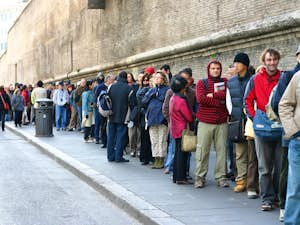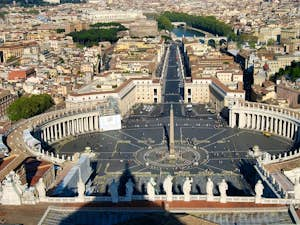Culture, endless beauty, and much more! Just a step away from St. Peter's Square, the Vatican Museums represent one of the essential stops on a visit to Rome. From the magnificence of the Sistine Chapel to the Raffaello's Rooms, to the works of Leonardo and Giotto, here you breathe pages of the history of the Bel Paese. The flip side? The legendary entrance queues that can cause discomfort during the visit.
Expecting a completely peaceful experience is impossible, however, there are some tricks to partly avoid the stress and enjoy the day to the fullest. Here are our useful tips and suggestions to follow for a worry-free visit to the Vatican Museums.
- Vatican Museums - One of the most visited museums in the world
- Vatican Museums - How timed tickets work
- Vatican Museums and St. Peter's Basilica: Visit from the Sistine Chapel
- How long does a visit to the Vatican Museums last?
- Sistine Chapel - The Creation of Adam and the Last Judgment
- What to See at the Vatican Museums
- Raphael's Rooms
- Vatican Pinacoteca
- Courtyard of the Belvedere
- Gallery of Maps
- Momo's Spiral Staircase
- Pio-Clementine Museum
- Rules and Services at the Vatican Museums: Other Useful Tips
Vatican Museums - One of the most visited museums in the world
It's no secret that, in some months of the year, the lines at the Vatican Museums can even be kilometers long.
With over 5 million visitors in 2022, the Vatican Museums continue to be among the TOP 5 most visited museums in the world, behind planetary icons like the Louvre in Paris and the MoMa in New York.
The period when you might find fewer crowds is between mid-November and March (excluding the weeks of Christmas and New Year's). In the last days of January, after the big wave of holidays, you might even get in fairly quickly. In high season, on the other hand, you can wait in line under the scorching sun for more than 4 hours. Agonizing!

Consider that already a few hours before 9:00, the museums' opening time, waves of visitors begin to fill the area around Viale Vaticano and crowd along the walls to gain entry: you'll see the line grow minute by minute. The hours up to mid-morning are undoubtedly the worst time of day to enter.
- During red flag periods and on holidays like Christmas and Easter, wait times can be 3 hours or more.
- Around 12:00 the line starts to thin out a bit, but this doesn't apply to high season, when the queues never stop.
For this reason, planning your visit is crucial if you've decided to go to the Vatican Museums. The first thing to do, of vital importance, is to get your tickets in advance.
Think about it: you're standing under the blazing sun or pouring rain in an endless line. The frustration can be felt even just imagining the scene. By the time your turn comes, you'll already be exhausted from the hours spent in line. It's precisely in those moments that you'll be bombarded by an army of scalpers offering overpriced guided tours with the promise of skipping the line and bypassing the obstacle.
Be smart and arrive there already armed with a skip-the-line ticket!
SKIP THE LINE AT THE VATICAN MUSEUMS AND ADMIRE THE SISTINE CHAPEL
Vatican Museums - How timed tickets work
The ticket for the Vatican Museums is for "timed entry". What does that mean? It means that at the time of booking, you must indicate the day and time you will visit the museum. Once you have purchased the ticket online, you will be sent a voucher via email that you will need to exchange for the actual ticket at the ticket office (you can print the voucher or show it directly from your smartphone or tablet); the meeting point varies depending on the type of ticket booked and is indicated within the email. Two considerations:
- By purchasing tickets online, you will avoid the line for ticket purchases but not the one for museum entry, considering that other people will have also chosen your same time slot when booking.
- Even with the online ticket, you will still need to go through security checks.
In summary, here are 4 useful TIPS for a "smart" visit to the Vatican Museums:
Book tickets online to make sure you skip the line, especially if you're traveling in high season.
The best time to visit the Vatican Museums is at lunchtime, between 1:00 pm and 3:00 pm. Keep that in mind when purchasing your ticket.
Avoid weekends and Mondays, when crowds might be larger since the museum is closed on Sundays (except the last Sunday of the month, when the site is open and admission is free from 9:00 am to 12:30 pm).
If you've opted for a "do-it-yourself" visit, plan in advance what to see and start already knowing what to prioritize.
SKIP THE LINE AT THE VATICAN MUSEUMS AND ADMIRE THE SISTINE CHAPEL
Vatican Museums and St. Peter's Basilica: Visit from the Sistine Chapel
Many visitors choose to combine a visit to the Vatican Museums with a visit to St. Peter's Basilica.

You have a wide choice of numerous guided tours that generally include priority entrance to the Sistine Chapel, as well as to the museums and the Basilica.
DISCOVER COMBINED TOURS: VATICAN MUSEUMS + ST. PETER'S BASILICA
If, instead, you were thinking of a self-guided visit and you're not sure what to prioritize, the suggestion is to enter the museums first, the most significant part of the experience, and then access the Basilica directly from the Sistine Chapel (to avoid further lines).
A USEFUL TIP: Once you have finished visiting the Sistine Chapel, you will see many tourists heading left. You take the door at the far right, there is a long corridor that leads directly to St. Peter's Basilica, from which you can enter for free and avoid further queues. After visiting the Basilica, you will exit directly into St. Peter's Square. Entrance to the Basilica from the Sistine Chapel closes around 5:00 pm, so make sure you have finished your visit to the Museums at least half an hour earlier to take advantage of this passage and quickly access the Church.
How long does a visit to the Vatican Museums last?
Guided tours of the Vatican Museums generally last about 3 hours. Even if you opt for a self-guided experience or a shorter tour, don't plan for less than 2 hours.

Sistine Chapel - The Creation of Adam and the Last Judgment
A visit to the Vatican Museums is practically incomplete without seeing the Sistine Chapel. Indeed, this is often the main reason that drives millions of tourists to hours and hours of waiting in line. Thinking of finding the Sistine Chapel empty is impossible, so be prepared to encounter difficulties even in moving from one area to another of the room.

The Cosmatesque-style floors and the walls with frescoes by Renaissance masters such as Botticelli, Perugino, Pinturicchio, and Ghirlandaio are also wonderful.
- Remember that the Sistine Chapel is the only area of the Vatican Museums where photography is prohibited.
No need to dwell here on the beauty of this artistic heritage: suffice it to know that people come from all over the world to admire the vault of the Sistine Chapel and its invaluable frescoes. A couple of tips might be useful for an intelligent visit. Consider that the Sistine Chapel is located at the end of the museum route. For this reason:
- If you have decided not to see St. Peter's Basilica, then as soon as you enter the Vatican Museums, head straight to the entrance of the Chapel. Once your visit is over, go back to see the rest of the collections you left behind.
- If you have decided to visit the Basilica, then keep the Sistine Chapel as the last area to visit and then access the Church through the door on the right.
- It may seem obvious or banal, but according to many, the best way to fully understand the beauty of this artistic treasure is to rely on a guided tour.
BOOK A GUIDED VISIT TO THE SISTINE CHAPEL
What to See at the Vatican Museums
The Sistine Chapel is the highlight of the visit, the jewel in the crown, but you can't stop there: it's really worth exploring the 7 kilometers of Art galleries in the Vatican Museums. If we wanted to describe everything there is to see, you could stay here reading for hours. However, there are rooms and areas absolutely not to be missed. If you have tight schedules and must necessarily give up something, we'll tell you the 6 things that, according to many users, should be seen at all costs:
Raphael's Rooms
Considered by many visitors to be one of the most beautiful areas of the Vatican Museums. All of Raphael's frescoes are wonderful, but special attention should be paid to the Room of the Segnatura, where you can admire the School of Athens. Many even consider it the TOP attraction after the Sistine Chapel frescoes.
Vatican Pinacoteca
Don't miss a visit to the masterpieces of the Vatican Pinacoteca. If you don't want to spend too much time, we suggest the two rooms not to be missed: Room VIII, completely dedicated to Raphael, which houses "The Transfiguration," the artist's last work before he died, and Room XII, which houses Caravaggio's "Deposition". If you can stay a little longer, two other "must-sees": Giotto's Stefaneschi Polyptych and Leonardo da Vinci's St. Jerome.
Courtyard of the Belvedere
One of the first areas encountered during the Vatican Museums Tour is the Courtyard of the Belvedere.

An enormous complex that houses, in turn, other distinct courtyards such as the "Court of the Pinecone." The name comes from its gigantic bronze pinecone of Roman origin, and in the center of the courtyard, you'll find Arnaldo Pomodoro's monument "Sphere within Sphere," today one of the most Instagrammed attractions by visitors.
Gallery of Maps
A magical place in the Vatican Museums, the largest collection of geographical paintings ever made. Life-size maps that incredibly accurately depict the geographical features of Italy, from mountain ranges to the expanse of the Tyrrhenian Sea. And you can't help but notice the ceiling of the gallery, sumptuously frescoed.
Momo's Spiral Staircase
You encounter Giuseppe Momo's spiral staircase at the end of the visit; it is indeed the staircase that leads to the museum exit. Beautiful from every angle and perfect for taking an artistic and alternative photo inside the Vatican Museums. Where else have you seen similar architecture? At the Guggenheim Museum in New York!
Pio-Clementine Museum
Even if you're not a fan of the Hellenistic period, you should make a stop at the Pio-Clementine Museum, the largest complex in the Vatican Museums with 12 rooms. It is in this museum that there are two "must-see" pieces, according to many, absolutely not to be missed: the marble group of Laocoon and the Apollo Belvedere.
Rules and Services at the Vatican Museums: Other Useful Tips
Like all the most visited sites in the world, there are rules to be respected even at the Vatican Museums.

- Wear comfortable shoes, as there is a lot of walking considering the 7 km of the entire museum route.
After your visit to the Vatican Museums, you are already ready for another adventure in the capital. Have you already included a tour of Villa Borghese in your travel itinerary?









